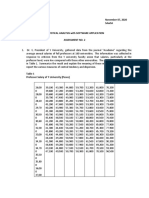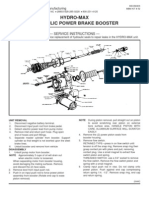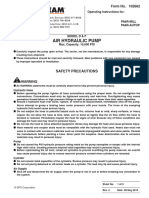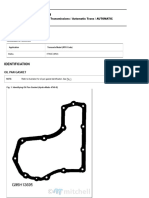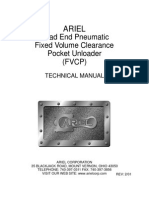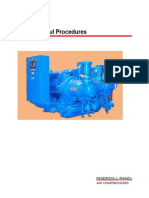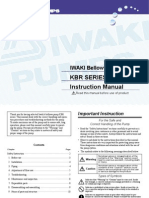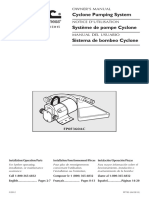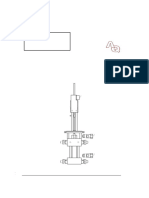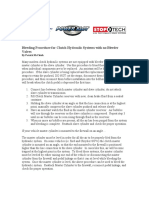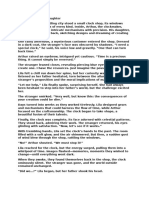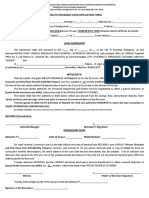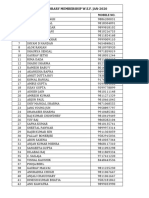Clutchmastercylinder Installation Instructions
Clutchmastercylinder Installation Instructions
Uploaded by
aliajordan41Copyright:
Available Formats
Clutchmastercylinder Installation Instructions
Clutchmastercylinder Installation Instructions
Uploaded by
aliajordan41Copyright
Available Formats
Share this document
Did you find this document useful?
Is this content inappropriate?
Copyright:
Available Formats
Clutchmastercylinder Installation Instructions
Clutchmastercylinder Installation Instructions
Uploaded by
aliajordan41Copyright:
Available Formats
Important: Always refer to vehicle-specific service manual for exact removal/installation detail
CLUTCH MASTER CYLINDER INSTALLATION
1. Disconnect pushrod from pedal. Replace eyelet bushing if broken during removal.
2. Remove interlock switch, if attached, from the pushrod.
3. In some applications, it may be necessary to disconnect battery, reposition components, and/or remove inner fender
to gain access to the clutch master cylinder.
4. Disconnect line fitting or drive out retaining pin holding hydraulic line to cylinder. If vehicle uses quick-connect
coupling in line, clean and uncouple using the proper disconnect tool.
5. Remove mounting bolts/nuts. For "Twist and Lock" type, rotate cylinder about 45 degrees clockwise and remove.
NOTE: some vehicles require counterclockwise rotation to remove.
6. Bench bleed new cylinder before installing. Block port, fill reservoir with DOT3 fluid, with cap removed. Using a
blunt tool, depress piston into cylinder slowly about 3/4"-1" and slowly release. Repeat until bubbles no longer
appear in reservoir or piston becomes hard to depress.
7. Repeat process in reverse order to install replacement cylinder.
8. Follow slave cylinder bleeding instructions below.
EXTERNAL CLUTCH SLAVE CYLINDER INSTALLATION
NOTE: Some slave cylinders are shipped with a plastic pushrod-retaining strap. DO NOT CUT OR REMOVE this strap,
as the bands are designed to break during the first clutch application. It then provides a non-metallic end for the pushrod
to prevent wear and noise.
1. Disconnect line or drive out the pin that holds the hydraulic line to the cylinder. Remove line. If vehicle uses quick-
connect fittings, use proper disconnect tool to uncouple.
2. Remove bolts or retainer holding cylinder to transmission. Remove cylinder.
3. Push in new cylinder's pushrod to disconnect retaining bands (if so equipped) and allow pushrod to fully extend.
DO NOT CUT OR DISCARD RETAINING STRAP.
4. Tip cylinder at about 45 degrees and pour DOT 3 brake fluid into hydraulic port until air is expelled. Insert hydraulic
line into port and carefully reconnect or drive in retaining pin.
5. Cylinders without bleeder screw: Hold slave cylinder vertically with pushrod facing down, making sure that slave is
lower than master cylinder. Slowly depress pushrod into cylinder about an inch while watching the reservoir for air
bubbles. Repeat process until air bubbles no longer appear, usually about 10-15 strokes. With reservoir lid removed,
slowly depress pushrod in far enough to reconnect the bands of the retaining strap (if so equipped). Install slave
cylinder on vehicle and replace lid on reservoir. Using slow short strokes, depress clutch pedal 10-20 times or until
pedal is firm.
6. Cylinders with bleeder screw: Install slave cylinder on vehicle. With reservoir lid removed and reservoir filled,
depress the clutch pedal with slow short strokes 10-20 times or until pedal is firm. Then depress pedal and hold it
down. Open the bleed screw on the cylinder to allow air and fluid to escape. Torque the bleed screw, then release
pedal (do not overtighten bleed screw). Repeat process until air is removed, clutch pedal is firm, and clutch engage-
ment is satisfactory. Maintain fluid level in reservoir during the bleeding process. Step 5 may be used in difficult
bleeding situations.
Bleed screw torque for Plastic cylinder (3 to 5 Nm); Aluminum cylinder (15 to 20 Nm)
INSTALLATION TIPS
• Be sure fluid supply and/or pressure lines are not kinked.
• Be sure pedal rod does not bind or stick. Lubricate at eyelet end.
• Do not allow lines to be closer than 4 inches from exhaust manifold/pipe (steel lines: 2 inches).
• Check quick-disconnect o-rings for cracking, splitting or contamination and replace if necessary.
BLEEDING TIPS
• Use only new brake fluid that meets DOT 3 or 4 specifications.
• Brake fluid absorbs moisture - keep container closed and do not reuse old fluid from the vehicle.
• Use caution in handling brake fluid. Prevent contact with skin, face, eyes, and painted surfaces. Use a container to
catch fluid during bleeding process.
• Prevent contact of any petroleum-based fluid (gas, oil, transmission or power steering fluid, etc.) with hydraulic
clutch system or brake fluid.
• If a damper exists in the hydraulic line, inlet and outlet ports must be vertical to properly bleed.
DAMPER QUICK DISCONNECT
TOOL 9999923 rev. 1
You might also like
- AP Lockheed Remote Servo ManualDocument8 pagesAP Lockheed Remote Servo Manualjblodwell100% (1)
- Rev D 900FH and 1000FH Turbine FiltersDocument12 pagesRev D 900FH and 1000FH Turbine FiltersJan AhmedNo ratings yet
- Saab Official Service Manual: 900 16 Valve: 1985-1993 - ExcerptDocument2 pagesSaab Official Service Manual: 900 16 Valve: 1985-1993 - ExcerptBentley PublishersNo ratings yet
- Gradall 534d 9 Parts ManualDocument3 pagesGradall 534d 9 Parts ManualWyteboi0% (1)
- Shimano Brake ManualDocument1 pageShimano Brake ManualscozansNo ratings yet
- Gardner Denver MH5 HydrapakDocument8 pagesGardner Denver MH5 HydrapakManualstoHelp0% (1)
- Manalo, Cristian James P. November 07, 2020 BSA 2-11 SawsaDocument5 pagesManalo, Cristian James P. November 07, 2020 BSA 2-11 SawsaCristian James ManaloNo ratings yet
- F.1/72 (16) /2019-R-II/SPC-II Union Public Service Commission Spc-Ii Section Important Instructions To The CandidatesDocument2 pagesF.1/72 (16) /2019-R-II/SPC-II Union Public Service Commission Spc-Ii Section Important Instructions To The CandidatesAdityaNo ratings yet
- I and O-1012 - 1014 - 1015 - and 1017 Pumps 1-1Document9 pagesI and O-1012 - 1014 - 1015 - and 1017 Pumps 1-1Mo'men AdelNo ratings yet
- Kit52 Instruction SheetDocument2 pagesKit52 Instruction SheettimmelbayashNo ratings yet
- PT 102662 Iom UsDocument5 pagesPT 102662 Iom UsMo ZeroNo ratings yet
- 26850A005Document12 pages26850A005Luciano AlencastroNo ratings yet
- Hydraulic CylinderDocument11 pagesHydraulic Cylindersrinathgudur11No ratings yet
- Pipe Bending MachineDocument8 pagesPipe Bending MachineAtif MehmoodNo ratings yet
- Hydraulic Disc Brake Hose Length Adjustment & Bleed GuideDocument100 pagesHydraulic Disc Brake Hose Length Adjustment & Bleed GuideIsmael OlayaNo ratings yet
- Portable Cargo Pump TK80 Simillar To Marflex Portable PPDocument18 pagesPortable Cargo Pump TK80 Simillar To Marflex Portable PPSubramoniam Marine100% (1)
- Maintenance and Repair InstructionsDocument12 pagesMaintenance and Repair InstructionsDhananjay NilkuteNo ratings yet
- Service Information: October/04 II 25 01/04Document3 pagesService Information: October/04 II 25 01/04Marcelo GiussaniNo ratings yet
- Operating and Maintenance Instructions On Tobul AccumulatorsDocument8 pagesOperating and Maintenance Instructions On Tobul AccumulatorszhenyupanNo ratings yet
- Manual 1008-1010Document12 pagesManual 1008-1010Edgar Eduardo Tellez RuizNo ratings yet
- Power Team PE18 ManualDocument8 pagesPower Team PE18 ManualTitanplyNo ratings yet
- Hydraulic Bottle Jack ManualDocument8 pagesHydraulic Bottle Jack ManualAlex Lake100% (1)
- Instruct For OperationDocument1 pageInstruct For OperationAriel Martinez NNo ratings yet
- Pump Manual Update June 2018Document8 pagesPump Manual Update June 2018Abdallah AbdelrehimNo ratings yet
- Midland PumpDocument12 pagesMidland Pumppeters petersNo ratings yet
- Plunger Pump Service Manual: Installation and Start-Up InformationDocument6 pagesPlunger Pump Service Manual: Installation and Start-Up InformationSubhendu KarNo ratings yet
- CUMMINS X15 Pump Head2250 REPAIRDocument31 pagesCUMMINS X15 Pump Head2250 REPAIRcristian picadoNo ratings yet
- Assessment Sheet: Student ID: Unit Code & NameDocument17 pagesAssessment Sheet: Student ID: Unit Code & NameheshanNo ratings yet
- Operating and Maintenance Instructions On Tobul AccumulatorsDocument8 pagesOperating and Maintenance Instructions On Tobul AccumulatorsGuru VagaNo ratings yet
- Automatic Transaxle ServicingDocument28 pagesAutomatic Transaxle ServicingpowerlabdieselsolutionsNo ratings yet
- Chapter 11Document21 pagesChapter 11igorNo ratings yet
- FVCPDocument14 pagesFVCPmichaelxiaoNo ratings yet
- 1CV Overhaul PDFDocument15 pages1CV Overhaul PDFsteve@air-innovations.co.zaNo ratings yet
- Activity 5. Assuming That You Are About To Perform Leak Test in Your Car. Make Your Own Procedures inDocument2 pagesActivity 5. Assuming That You Are About To Perform Leak Test in Your Car. Make Your Own Procedures inkhathleneNo ratings yet
- Mercury Maintenance ManualDocument27 pagesMercury Maintenance ManualJens Adam Hedegaard HansenNo ratings yet
- Service Instruction: LycomingDocument4 pagesService Instruction: LycomingGANo ratings yet
- d8k Tractor - Power Shift - 66v00001-02084 (Machine) (Hebp1007 - 01) - Sistemas y ComponentesDocument5 pagesd8k Tractor - Power Shift - 66v00001-02084 (Machine) (Hebp1007 - 01) - Sistemas y ComponentesJose MontalvoNo ratings yet
- Ar ManualDocument43 pagesAr ManualParamasivan. SNo ratings yet
- KBR T407-3 Manual PDFDocument12 pagesKBR T407-3 Manual PDFgiulian2009No ratings yet
- Brake BleedingDocument5 pagesBrake BleedingYan ArmanaNo ratings yet
- Flowtec Pump Manual 528Document20 pagesFlowtec Pump Manual 528icarus_fallenNo ratings yet
- Wood's Powr-Grip Guide To Maintenance, Troubleshooting, and RepairDocument4 pagesWood's Powr-Grip Guide To Maintenance, Troubleshooting, and Repairkamikadze7No ratings yet
- Belt Filter PressDocument5 pagesBelt Filter PressMaku RajkumarNo ratings yet
- 3088 Instruction Manual (D) - 230911 - 142910Document20 pages3088 Instruction Manual (D) - 230911 - 142910gguadian21No ratings yet
- Maintenance: Outboard CareDocument18 pagesMaintenance: Outboard Careshygal1981100% (1)
- Installation, Operation and Maintenance Instructions Stainless Steel, Liquid Ring Vacuum PumpsDocument28 pagesInstallation, Operation and Maintenance Instructions Stainless Steel, Liquid Ring Vacuum PumpspinplataNo ratings yet
- Range Rover Manual Brakes PDFDocument78 pagesRange Rover Manual Brakes PDFPablo Pacheco Reyes100% (2)
- Bleeding Hydraulics With No Bleeders 1Document1 pageBleeding Hydraulics With No Bleeders 1balmohankNo ratings yet
- Disamble Cylinder HeadDocument17 pagesDisamble Cylinder HeadFredy Mauricio Diaz VargasNo ratings yet
- SM - Kymco Vitality 50 - Chapter 12 Carburetor)Document29 pagesSM - Kymco Vitality 50 - Chapter 12 Carburetor)jose sousa oliveiraNo ratings yet
- Ideal Installation: I & M Mark 68G SeriesDocument4 pagesIdeal Installation: I & M Mark 68G SeriesByron PanchiNo ratings yet
- Maintenance ScheduleDocument16 pagesMaintenance ScheduleSiska0806No ratings yet
- Ac Compressor ServicingDocument25 pagesAc Compressor ServicingffyddNo ratings yet
- Hydro CyclonesDocument7 pagesHydro CyclonesMohamed Ali HorrigueNo ratings yet
- Brake Bleeding SRDocument2 pagesBrake Bleeding SRWidia AstutiNo ratings yet
- Air CylinderDocument4 pagesAir Cylindersimbua720% (1)
- Circulation Pump A27-A30angDocument11 pagesCirculation Pump A27-A30angpavan3229100% (1)
- G-Tech Rotary Lobe Pump OIM Manual PDFDocument23 pagesG-Tech Rotary Lobe Pump OIM Manual PDFGiorgiana Rosu100% (1)
- Clu 1201Document1 pageClu 1201Aleix RamirezNo ratings yet
- 42 80 - 4280 Motor Mounted Pump - IOI PDFDocument4 pages42 80 - 4280 Motor Mounted Pump - IOI PDFLokesh ModemzNo ratings yet
- N2 Triplex Pump-MaintenanceDocument14 pagesN2 Triplex Pump-MaintenanceIbrahim Ahmed100% (1)
- Types of Valves in Piping: Types of Valves - Tables to estimate man hours of assemblyFrom EverandTypes of Valves in Piping: Types of Valves - Tables to estimate man hours of assemblyNo ratings yet
- Grad 2017 LyricsDocument2 pagesGrad 2017 LyricsRay Chris Ranilop OngNo ratings yet
- McGlone 2005 Journal of BiogeographyDocument2 pagesMcGlone 2005 Journal of BiogeographyChristian MoscosoNo ratings yet
- 0609 - Bank Secrecy Presentation - Alan W. GranwellDocument58 pages0609 - Bank Secrecy Presentation - Alan W. GranwellgivamathanNo ratings yet
- Syllabus: International Institute of Professional Studies Davv, IndoreDocument13 pagesSyllabus: International Institute of Professional Studies Davv, IndoreKavish SharmaNo ratings yet
- 23UHV02-UHV SYLLABUS AND NOTESDocument77 pages23UHV02-UHV SYLLABUS AND NOTESmanjunadhasompalleNo ratings yet
- District LibraryDocument7 pagesDistrict LibraryRawan GhanemNo ratings yet
- Summary and Analysis EliminatingDocument2 pagesSummary and Analysis EliminatingKrishnanunni Karayil UllasNo ratings yet
- Mutant - SabroToneDocument1 pageMutant - SabroToneMajk StoneNo ratings yet
- Grade 3 AMO: Fill in The BlanksDocument3 pagesGrade 3 AMO: Fill in The BlanksSách.Cộng21 21No ratings yet
- Business Environment Report OnDocument6 pagesBusiness Environment Report OnzombeeeeNo ratings yet
- Recipe SpecificationsDocument6 pagesRecipe SpecificationsRovie Valdez100% (3)
- Macbook All-In-One For Dummies Cheat Sheet: Mac Os X Finder Keyboard ShortcutsDocument1 pageMacbook All-In-One For Dummies Cheat Sheet: Mac Os X Finder Keyboard ShortcutsRyuzaki LawlietNo ratings yet
- Ebook PDF CB New Engaging Titles From 4ltr Press 8th Edition PDFDocument41 pagesEbook PDF CB New Engaging Titles From 4ltr Press 8th Edition PDFjohn.vail635100% (48)
- Mt233B: Kinematics: Learning ModuleDocument40 pagesMt233B: Kinematics: Learning ModuleJohn Nathaniel Batulan SenayoNo ratings yet
- Fresher Juice Activation PlanDocument14 pagesFresher Juice Activation PlanMalik Muhammad SufyanNo ratings yet
- Java 5 CH 11 MCAnswersDocument13 pagesJava 5 CH 11 MCAnswersAbigael HNo ratings yet
- 1203 Weight Transmitter Reference Manual: For Use With Software Versions 1.0 and AboveDocument56 pages1203 Weight Transmitter Reference Manual: For Use With Software Versions 1.0 and Abovesongs SomervilleNo ratings yet
- Mystery Tunnels of South AmericaDocument3 pagesMystery Tunnels of South AmericaCarlos Diez De MedinaNo ratings yet
- Research TitleDocument25 pagesResearch TitleMonica MinaNo ratings yet
- Pittsfield Schools FY16 Budget BookDocument117 pagesPittsfield Schools FY16 Budget BookiBerkshires.comNo ratings yet
- PATRI Framework For Scaling Social ImpactDocument26 pagesPATRI Framework For Scaling Social ImpactRizwan Tayabali50% (2)
- English 4 Q2 M5 Week5 MELC05 Simple Present Tense of Verbs - MaElainePre - FINALDocument11 pagesEnglish 4 Q2 M5 Week5 MELC05 Simple Present Tense of Verbs - MaElainePre - FINALLaine RepNo ratings yet
- ResearchDocument6 pagesResearchMonil ChhedaNo ratings yet
- The Clockmaker's DaughterDocument2 pagesThe Clockmaker's DaughternicksmcdonaldNo ratings yet
- DLL - Mapeh 6 - Q2 - W5-JLMTDocument6 pagesDLL - Mapeh 6 - Q2 - W5-JLMTnekorish 2No ratings yet
- Hi 263 Central AfricaDocument165 pagesHi 263 Central AfricaAlbert MoshiNo ratings yet
- Option 1 Loan Form NewDocument1 pageOption 1 Loan Form Newron arwin nathaniel palmares100% (1)
- TM January 2020 SFSCDocument5 pagesTM January 2020 SFSCJitendra SinghNo ratings yet






